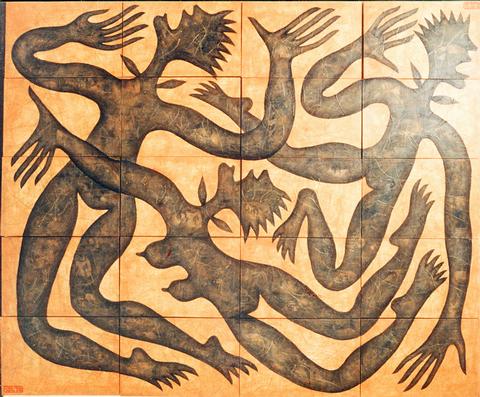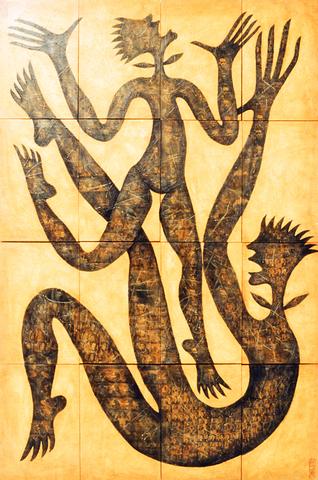This work was titled `Yellow River' in China, but I called it `Tamshui River' here. It was called by some other river's name when exhibited in Germany," said Chinese artist Ren Rong
Easily adapting the titles of his works to suit any country, the Bonn/Beijing-based artist views Ren Rong, his second touring exhibition since 1999, as a cultural exchange between countries. Titling the exhibition after himself, Ren had brought this "record of my life, people I had contact with and places I visited" to six cities in Germany before coming to Taipei. It will be heading for Taichung's Stock 20 in July before moving on to Hong Kong, Beijing, Jerusalem and more German cities.
River consists of 80 small-format paper cuts mounted on cardboard surfaces. They were in a flowing linear formation meandering across an entire wall in the gallery.

These black paper cuts are of "plant people"
The origin of the creature goes back to Ren's pre-college days. "I used to love painting human nudes. The human body's natural texture had great appeal for me. When placed in nature or among plants, it blends in with perfect harmony," Ren said in an telephone interview with the Taipei Times.
After college, it occurred to Ren to blend natural and human nudes into one creature, which, according to Ren, is ever-growing and freely reproducing.

PHOTOS COURTESY OF REN RONG
The fact that "plant people" means the "brain-dead" in Taiwan has been a constant joke among Ren's Taiwanese friends. "I invented the phrase in German. `Pflanzenmenschen' is a poetic word. For me, it represents the `ultimate exercise' -- constant movement, transformation and growth. Plant people are by no means stationary," Ren said.
These spiky-head plant people wear a hard-working expression. Their limbs strenuously stretch out and sometimes entwine with other plant people. The effect of exertion is further enhanced by their extending fingers and toes that seem to be reaching out to grab something.
The background cardboard is a collage of comics, maps, newspaper clippings and calligraphy in Chinese and German, which Ren has been collecting since he moved to Germany in 1986.
"Ren's popularity in Germany is due more than a little to the Oriental, or exotic, appeal of his paper-cuts," said Weng Suying (翁淑英), promotion chief at Hong-Gah. "The contrasting color scheme of red and black and the simplified human forms similar to traditional Chinese New Year decorations create a typical Chinese style," Weng said, referring to Ren's Positive and Negative, a collage of 200 paper cut plates. The Negative part is also on show at Hong-Gah.
For the Taiwan show, Ren made people plant people -- six new large paper-cuts on cardboard.
One of the series shows three plant people seemingly halfway in their stunt with details from an ancient painting Fire Mountain in Xinjiang in the background. Ren's photo portraits are densely superimposed on the silhouettes. Beeswax is sprayed on the bright earth-toned paper to create a warm texture. The vitality of the work seems to reach out from the paper.
"I was born under the element of fire. That fire mountain has special meaning for me. So it figures in my works. That's how I create works. My life and my work are one," Ren said, explaining the creative process of the works which are more like his diaries.

On April 26, The Lancet published a letter from two doctors at Taichung-based China Medical University Hospital (CMUH) warning that “Taiwan’s Health Care System is on the Brink of Collapse.” The authors said that “Years of policy inaction and mismanagement of resources have led to the National Health Insurance system operating under unsustainable conditions.” The pushback was immediate. Errors in the paper were quickly identified and publicized, to discredit the authors (the hospital apologized). CNA reported that CMUH said the letter described Taiwan in 2021 as having 62 nurses per 10,000 people, when the correct number was 78 nurses per 10,000

As we live longer, our risk of cognitive impairment is increasing. How can we delay the onset of symptoms? Do we have to give up every indulgence or can small changes make a difference? We asked neurologists for tips on how to keep our brains healthy for life. TAKE CARE OF YOUR HEALTH “All of the sensible things that apply to bodily health apply to brain health,” says Suzanne O’Sullivan, a consultant in neurology at the National Hospital for Neurology and Neurosurgery in London, and the author of The Age of Diagnosis. “When you’re 20, you can get away with absolute

May 5 to May 11 What started out as friction between Taiwanese students at Taichung First High School and a Japanese head cook escalated dramatically over the first two weeks of May 1927. It began on April 30 when the cook’s wife knew that lotus starch used in that night’s dinner had rat feces in it, but failed to inform staff until the meal was already prepared. The students believed that her silence was intentional, and filed a complaint. The school’s Japanese administrators sided with the cook’s family, dismissing the students as troublemakers and clamping down on their freedoms — with

As Donald Trump’s executive order in March led to the shuttering of Voice of America (VOA) — the global broadcaster whose roots date back to the fight against Nazi propaganda — he quickly attracted support from figures not used to aligning themselves with any US administration. Trump had ordered the US Agency for Global Media, the federal agency that funds VOA and other groups promoting independent journalism overseas, to be “eliminated to the maximum extent consistent with applicable law.” The decision suddenly halted programming in 49 languages to more than 425 million people. In Moscow, Margarita Simonyan, the hardline editor-in-chief of the